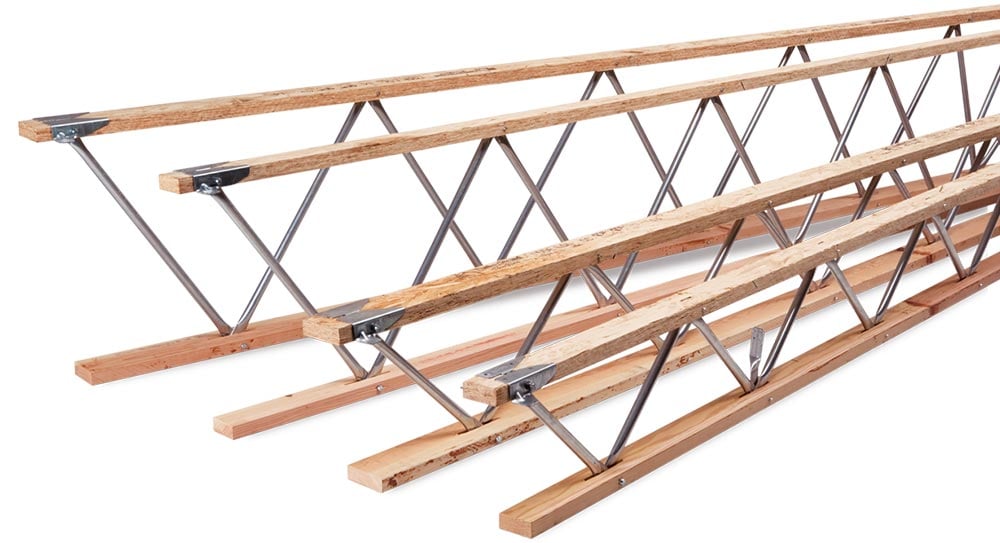Table Of Content
- Structural Building Components Magazine
- EXPERIENCE EXCEPTIONAL STRENGTH, FLEXIBILITY, AND LABOR SAVINGS WITH FLOOR TRUSSES
- What is a Floor Truss – Types, Benefits, & Usage
- Subscribe to Industry News
- Floor Trusses vs. I-Joists vs. Floor Joists – The Difference
- ELIMINATE WASTE AND IMPROVE CYCLE TIME WITH OPEN WEB FLOOR TRUSSES
- Why spec RedBuilt™ Open Web Trusses?
Furthermore, trusses are made using exceptionally quality lumber, which minimizes the risk of shrinkage, warping, and twisting, reducing maintenance costs. Moreover, they are easier to work with and provide a nailing surface of about 3.5”, greater than the 2.5” surface offered by most I-joists. For instance, a wooden truss can span up to 30 feet, which is much greater than a traditional joist. They also allow for the construction of longer spans, are reusable, and require less labor to install. Howe trusses are more popular than Pratt trusses because of their superior load-dissipating capabilities.
Structural Building Components Magazine
Trimjoist’s in-house engineering staff is always on hand to assist contractors, architects and building designers in plan conversion and design layout. They provide detailed floor-framing plans and precise material lists for each project, which ensures the trusses are shipped and installed right the first time. Plus, joists are more likely to crack, twist, and bounce than floor trusses. Once the plan is created, the floor trusses are designed to fit the allocated space.
EXPERIENCE EXCEPTIONAL STRENGTH, FLEXIBILITY, AND LABOR SAVINGS WITH FLOOR TRUSSES
Floor joists come in many sizes, but they usually range from 2 x 8’ to 2 x 12’. Sometimes, they can also be 2 x 6’, although these sizes are not very common and are mostly seen in older homes. The TrimJoist® can be quickly incorporated into any house plan and is the first step to a floor system with superior quality and superior support.
What is a Floor Truss – Types, Benefits, & Usage
Therefore, diagonal members in Pratt trusses are made of lighter and thinner steel. This certification program comprised of SBCA programs to provide component manufacturers with methods to implement the industry’s best practices. With that complete, the truss is lifted and placed for shipment to its destination. In addition, the short nature of the lumber used in the trusses means less warping, twisting, or shrinking. Receive a weekly newsletter on component manufacturing news from SBC Magazine.

Additionally, they have an open web design which allows easy access for utilities. Pratt trusses have a unique arrangement, and their diagonal members slant towards the middle. Michael Straessle has written professionally about the construction industry since 1988. He authored “What a Strange Little Man,” among other books, and his work has appeared in various online publications. Straessle earned a Bachelor of Arts from the University of Arkansas at Little Rock in professional/technical writing.
Keyed Bearing or Shared Bearing details allow two different floor trusses to share the same interior bearing and stay aligned, eliminating the need to stagger or overlap the two trusses. Sheathing installation is much easier because the supporting trusses line up, significantly reducing the need to cut special sheathing pieces to complete the subfloor. The result is a cleaner detail with full bearing while reducing labor and material usage. Floor trusses and joists are used to support weight and provide structural support.

With floor trusses, you can simply run equipment through the webbing or provide horizontal chases in the trusses to provide the space needed. Wood is in fact a renewable resource, affordable, easy to work with, and provides enough strength for most projects. Wood products range from commodity lumber (2x4s, 2x6s, etc.), engineered lumber, (LVLs, Plywood, etc.), and pre-fab trusses. In today’s blog, we discuss floor trusses and what benefits they offer to both single-family homes and multi-family projects. These bearings need to be supported by an adequate support structure downward though the wall to any floor systems below and into the foundation system of the structure. Floor trusses are the solution to many floor framing challenges presented in today's complex and sophisticated building designs.
Ft. homes were built – one conventionally framed, the other built with engineered components – to highlight the benefits of building with roof trusses, floor trusses and wall panels. Floor trusses feature built-in ribbon notches that can be designed/customized to receive any dimension of 2x lumber desired. Continuous ribbons provide stability for installed trusses and a solid surface for the edge nailing of floor sheathing. This approach eliminates the need for larger and more expensive band-board solutions required by dimensional lumber and other engineered wood products.
Why spec RedBuilt™ Open Web Trusses?
This is the most common type of chord-bearing condition in floor trusses and is designed to sit on top of bearing walls. Other trusses can also be used to support adjacent trusses connected at some type of angle, usually 90 degrees with a metal connector joist or truss hanger. In some instances with very light loads, trusses can be nailed together to act as a bearing condition. The bearing supporting the girder truss is most likely to suffer from the crushing effects mentioned above. I-joists have a top and bottom chord, like trusses, but the space is filled chiefly with ½” or 5/8’ plywood.
Factors that determine the size of the top chord include on-center spacing, dead and live loads applied to the truss, span, and pitch applied to the top chord. In addition to the top chord and webs, the bottom chord is used to transfer forces to the truss bearings. For traditionally spaced trusses, the bottom chord is cut out of 2x4 or 2x6 dimension lumber but can also be cut out of 2x8, 2x10, 2x12, and even LVL material for roof trusses. Factors that determine the size of the bottom chord include on-center spacing, dead loads applied to the truss, span, and if there is any pitch applied to the bottom chord. An example of this is a vaulted ceiling application framed by scissors trusses. In some cases a live load can be applied to a bottom chord, either for storage purposes or if there will be movement within the truss, such is the case in an attic truss.
Floor trusses and joists are an essential part of any construction project, and it’s helpful to know their advantages and disadvantages and the types available. Most people divide them into three categories, but here are five types of floor trusses and joists. Open Web Trusses are available in nine profiles so you can design and build almost anything. Whether your project has an incredibly long span or is a typical light commercial job, we have a solution. With a high strength-to-weight ratio, open web trusses are uniquely suited for large open spaces and easy installation of plumbing, electrical, and ductwork. We build each truss by hand specifically for your job, then ship it upright for strict quality assurance.
Having your design team involved in the process can save thousands in on-site repair. Webs are typically cut with many angles on each end to allow for a tight fit at the joint. Linear saws are able to quickly cut differing webs out of one piece of lumber thereby minimizing waste. Component saws are utilized to cut high volumes of webs of the same configuration out of a fixed length board using 5 or 6 saw heads. Pull saws, either manual or semi-automated, are used to cut a variety of parts including webs in low quantities. Common trusses are typically designed with symmetrical webs to reduce the number of saw setups and make the overall truss fabrication process less complicated.
Fast, Accurate Floor Sheathing - Fine Homebuilding
Fast, Accurate Floor Sheathing.
Posted: Tue, 17 Nov 2020 18:51:40 GMT [source]
Our trusses provide more design flexibility, inside and out, than conventional framing. Offering numerous custom design options, our trusses present an economical and structurally superior method for rapid erection. Floor trusses can have 16”, 19.2”, and 24” spacing based on the size of the floor, the applied load, and truss strength. This truss is common in residential buildings with spans ranging from 65 to 330 feet, where gravity loads dominate.
Wooden floor trusses are cheaper and easier to install but allow for smaller spans to be built. One of the most common support systems for floors in houses and commercial buildings is the open-web truss system. Their appearance makes them seem easy to build because they look as if they are just straight pieces of lumber with angled pieces between them. A preassembled unit of floor joists, subflooring, finished flooring, and sometimes ceiling below supported by walls, columns, or beams. Bearing width knowledge is critical to truss design to ensure the truss meets expectations in the construction process. If the bearing size varies from the truss design, the ceiling area can be impacted where it meets the wall and modifications will be necessary when installing drywall or other finish products.
Floor trusses are engineered with open web designs capable of spanning longer than traditional wooden I-joists. Various types of floor trusses are used in a floor system, including Warren, Pratt, and Howe trusses. Triangulation is the engineering practice of forming rigid triangles together with adequate fasteners at the joints. It typically involves the use of triangular shapes to give stability to structures. In roof and floor trusses, wooden triangles are used to pass compression and tension forces throughout the structure to its bearings.
Panel points are located where web members intersect with top or bottom chords, which are connected by metal connector plates. Panel points determine the length of the panel and webbing formation of the truss. Shifting panel points even small distances can impact the efficiency of the truss and transform a truss that doesn’t pass design requirements to a truss that does. In floor truss applications, 2x4 or 2x3 material is typically used with the wider portion of the board resting on the bearing or what is known as a 4x2 configuration. Gable end floor trusses, sometimes called ladders, provide a strong alternative to large dimensional lumber for parallel closure.

No comments:
Post a Comment